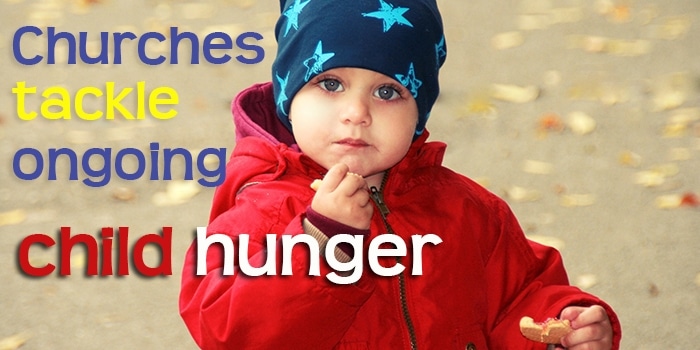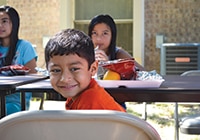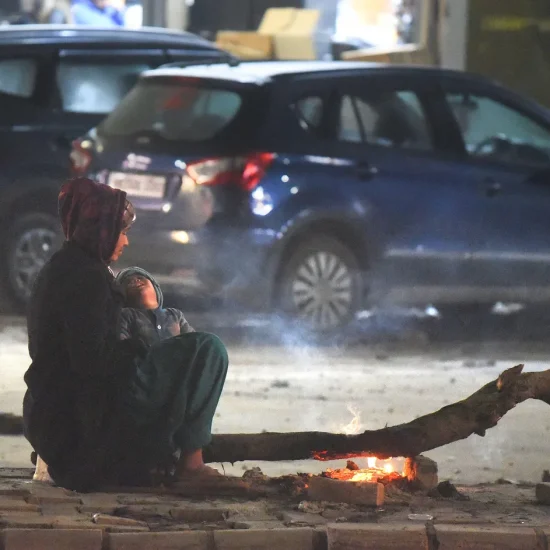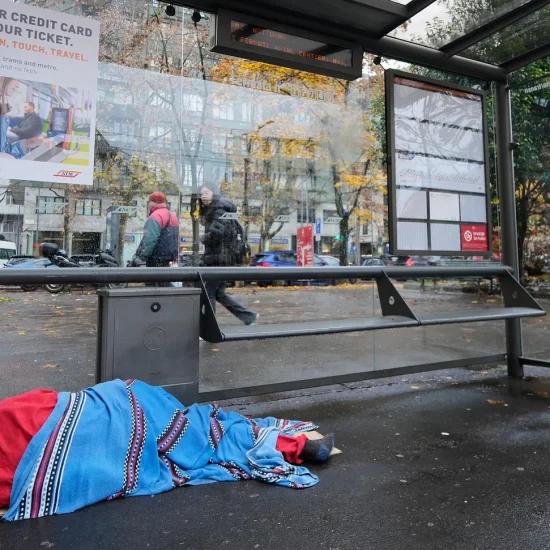
As the last bell rings in late May or early June, throngs of schoolkids rush from their school to celebrate the start of summer. More time to play games, more opportunities to sleep and less homework. Yet, for some children, summer also means fewer meals.
More than 20 million kids — about half of public school children in the U.S. — receive free or reduced lunches during the school year. When summer break comes, governmental agencies, schools and churches work to fill the gap.
 School-age children enjoy a free meal at a summer meals site in Alamo, Texas.Teri Shipley, pastor of Cornerstone Church (a Cooperative Baptist Fellowship congregation in Lee’s Summit, Mo.), said the church helped start a nonprofit called Coldwater about seven years ago to help reduce child hunger in their community. They started by helping kids during the school year by providing Harvesters“ BackSnacks,” a backpack of nutritious food to help kids who otherwise might go hungry over the weekend. Harvesters is a regional foodbank serving northwestern Missouri and northeastern Kansas.
School-age children enjoy a free meal at a summer meals site in Alamo, Texas.Teri Shipley, pastor of Cornerstone Church (a Cooperative Baptist Fellowship congregation in Lee’s Summit, Mo.), said the church helped start a nonprofit called Coldwater about seven years ago to help reduce child hunger in their community. They started by helping kids during the school year by providing Harvesters“ BackSnacks,” a backpack of nutritious food to help kids who otherwise might go hungry over the weekend. Harvesters is a regional foodbank serving northwestern Missouri and northeastern Kansas.
“We found that the school district and our local food pantries had limitations when working with churches that wouldn’t exist if working with a not-for-profit organization,” explained Shipley, who serves as president of Coldwater’s board.
“This was our reason for starting Coldwater. As we worked with our local Harvesters organization to provide BackSnacks for weekend food insecurities with a limited amount of elementary students we became more and more aware of the need in our community,” she said. “When the first summer rolled around and BackSnacks were done for the summer we were troubled by the lack of food these kids would have access to throughout the summer.”
Recognizing the need for food programs over the summer, Shipley said they worked to expand their “No Hungry Kids!” program. However, privacy policies made it difficult since they did not know which students received the BackSnacks or free or reduced lunches.
“We implemented two programs: summer sack lunches and summer BBQs,” she said. “We targeted government-assisted housing complexes and worked with the management there to bring in sack lunches M-F with visits from the librarian, the zoo, balloon artists and more. Then we brought grills and tables and yard games on Wednesday nights to the same locations and shared hamburgers and hot dogs together. We have made many wonderful friends over the years.
“We also host what we call ‘Friends Day’ on the second and fourth Saturday of the month,” Shipley added. “Our friends come to Cornerstone. We start with coffee and donuts about 10:30 and we share a hot lunch, offer food from our pantry and a visit to our clothes closet as well.”
Silas Johnson, pastor of Calvary Missionary Baptist Church in Springfield, Ill., similarly sees a need for churches to help tackle summer hunger. His church serves as a feeding site through the U.S. Department of Agriculture’s Summer Food Service Program. This federal program, usually operated through a state’s department of education, pays for summer meals for qualifying children. Like Calvary, many of the Baptist churches participating in the Midwest are predominately African-American.
Johnson said Calvary, which has provided meals for more than 20 years, offers lunch to between 50 and 100 children a day. Church members serve as volunteers who run the program. He noted that without the program, some children “may not get but one meal a day — and sometimes not even that.”
“We’ve impacted our community quite a bit,” he added. “Our church has been blessed by our efforts of reaching out. Every church that possibly can should open their doors.”
Johnson said some parents even stay and eat — at a small cost — with their children. He added that Calvary also provides an educational program following the meal to help prevent loss of information during the summer months. Curriculum includes reading, math and English skills in addition to times for outdoor exercise and recreation for the children.
Biblical calling to feed the hungry
Shipley noted biblical mandates to urge Christians to work to eliminate food insecurities. Pointing to Matthew 10, she said Christians need to welcome and serve others, like giving a cup of cold water to someone who is thirsty.
“Jesus commissioned us to make disciples, and it seems the best way to do that is invest in the lives of those he brings to our lives,” she said. “We get overwhelmed at times with the hunger issues that continue, despite our best efforts. We find hope comes in the form of friends coming together and giving and taking as we need.”
Johnson also believes this ministry “comes from scripture.”
“For our church, this is part of our missions,” he said. “We have missionary in our name. This is part of our outreach when we go beyond our walls. When we reach out and feed the hungry and reach out and, when necessary, clothe the naked.
“People need to be concerned about their neighbors,” he added. “We are our brother’s keeper.”






